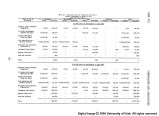| OCR Text |
Show PART III PRESENT STATUS OF DEVELOPMENT (1965) This part summarizes the 19&5 base year level of water and related land utilization, management, and development. The principal uses of wa- ter and land are presented and the major economic activity discussed. The agricultural base in the region is primarily a cow-calf and sheep enterprise utilizing 1,5 million acres of irrigated and dryland feed crops and 60 million acres of Federal and private grazing land. Also marketed are cash crops from 505000 acres, such as fruit, sugar beets, Moravian malting barley, and vegetables. Dry beans and wheat are also grown as cash crops on 301,000 acres of both dry and irrigated farms. Presently 12^,000 acres of irrigated land are idle and 185,000 acres of dry cropland are not cropped annually. Industrial development in the basin represents a substantial part of local economic activity. Remote location, limited supply of labor, and unavailability of capital resources have affected growth. Petroleum, mo- lybdenum, coal, uranium, and trona dominate present production and value in the mineral industry. Thermal-electric power generation utilizing lo- cal coal resources has an installed capacity of 1,335 megawatts. Timber products harvested in 1965 amounted to 53 million cubic feet, of which about half, or 311 million board feet, was sawtimber. The region is part of one of America's outstanding recreation and tourist areas in a quality environment setting. Abundant fishing and hunting exist for both residents and nonresidents. Main-stem storage development provides 33 million acre-feet of stor- age regulation to meet outflow requirements from the region and allow for regional development. These facilities include 1,300 megawatts of in- stalled capacity for hydroelectric power and have a large potential for water-based recreation. 1965 Water Development The total water supply, which assumes no depletion by man's activi- ties, averages 3J+.87 million acre-feet annually based upon the period 191^-65. On-site depletion and evaporation from reservoirs on the main stem of the Colorado River for long-term average or normalized conditions were 3.45 million acre-feet. The chart following page 2k depicts tlie 1965 normalized flow and depletions. Tables 1 and 2, page 2U? show a breakdown of the depletion by subregion and states for the various uses . 23 |













































































































































